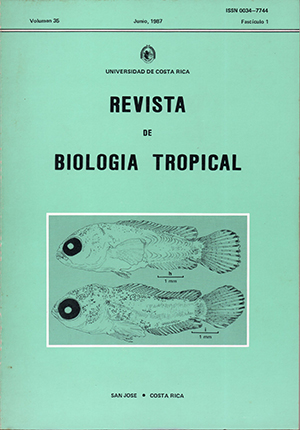Resumen
Se probó la respuesta in vitro de Necator americanus a 20 antihelmínticos. Con valores de EC50 desde 0 .0002 hasta 0 .0007 mg/L, los antihelmínticos de espectro amplio afectaron a machos, hembras y estadíos libres. Ciertas drogas emetine, praziquantel y suramin) afectaron selectivamente a los grupos mencionados al nivel de 10.0 mg/L. Las hembras requirieron mayores niveles de tratamiento, lo que tiene importantes implicaciones en la aplicación de antihelmínticos.
Citas
Broome, AW. J. & N. Greenhalgh. 1961. A new anthelmintic with unusual properties. Nature 189: 59-60.
Coles, G. C. & R, M. McMeillie. 1977. The response of nematodes in vivo and in vitro to some anthelmintics, Journal of Helminthology 51: 323-326.
Copp, F. C., O. D., Standen, J. Scarnwell, D. A. Rawes & R, B. Burrow, 1958. A new series of anthelmintics, Nature 181: 183.
Ibarra, O. F. & D. C. Jenkins, 1984. The relevance· of in vitro anthelmintic screening tests employing the free-living stages of trichostrongylid nematodes. Journal of Helminthology 58: 107.
Jenkins, D. C. 1982. In vitro screening tests for anthelmintics. In "Animal Models in Parasitology" (D. G. Owen, ed.) pp. 173- 186. Mc Millan Press, London
Jenkins, D. C. & T. S. Carrington. 1981. An in vitro screening test for compounds active against the parenteral stages of Trichinella spiralis. Tropenmedizin und Parasitologie 32: 31-34.
Jenkins, D. C. & T. S. Carrington. 1982. An in vitro screen for anthelmintics employing worms of Nippostrongylus brasiliensis in a defined medium. Veterinary Parasitology 11: 223-230.
Jenkins, D. C., R. Armitage & T. S. Carrington, 1980. A new primary screening test for anthelmintics utilizing the parasite stages of Nippostrongylus brasiliensis in vitro. Zeitschrift fur Parasitenkunde 63: 261-269.
Katiyar, J. C. & A. B. Sen. 1969. A new technique for rapid screening of potential nematocidal compounds. Indian Journal of Parasitology 31: 132-134.
Leland, S. E., G. R. Ridley, C. F. Slonka & G. L. Zimmerman. 1975. Detection of activity for various anthelmintics against in vitro produced Cooperia punctata, American Journal of Research in Veterinary Sciences 36: 449-456.
Levine, N. D. 1950. The use of horse strongyle larvae in screening compounds for anthelmintic activity. Transactions of Illinois State Academy of Science 43: 233-236.
Phillipson, R. F. 1966. Life-cycle and chemotherapeutic studies on Nippostrongylus brasiliensis. Ph. D. Thesis, University of London.
Sheffield, H. G., J. E. Meisenhelder & P. E. Thompson. 1959. The effects of reference anthelmintics against N. dubius and oxyurids in mice relative to screening procedures for new drugs, Journal of Parasitology 45: 653-658.
Simpkin, K, G. & G, C. Coles. 1981. The use of Caenorhabditis elegans for anthelmintic screening, Journal of Chemical Techniques and Biotechniques 31: 66-69.
Standen, O. D. 1963. Chemotherapy of helminthic infections, In "Experimental Chemotherapy" (R. 1. Sehnitzer & F. Hawking, eds.) pp. 701. Academic Press.
Steward, J. S. 1955. Anthelmintic study: A double enteronemacidal anthelmintic test covering a wide range of activities, Parasitology 45: 242-254.
Stone, O. J., J. F. F. Mulins & C. C. Wells. In vitro studies on Ancylostoma caninum with thiabendazole with observations on larval exsheathment. Journal of Investigations on Dermatology 44: 256-258.
Tiner, J. D. 1958. A preliminary in vitro test for anthelmintic activity. Experimental Parasitology 7: 292-305.
##plugins.facebook.comentarios##

Esta obra está bajo una licencia internacional Creative Commons Atribución 4.0.
Derechos de autor 1987 Revista de Biología Tropical


